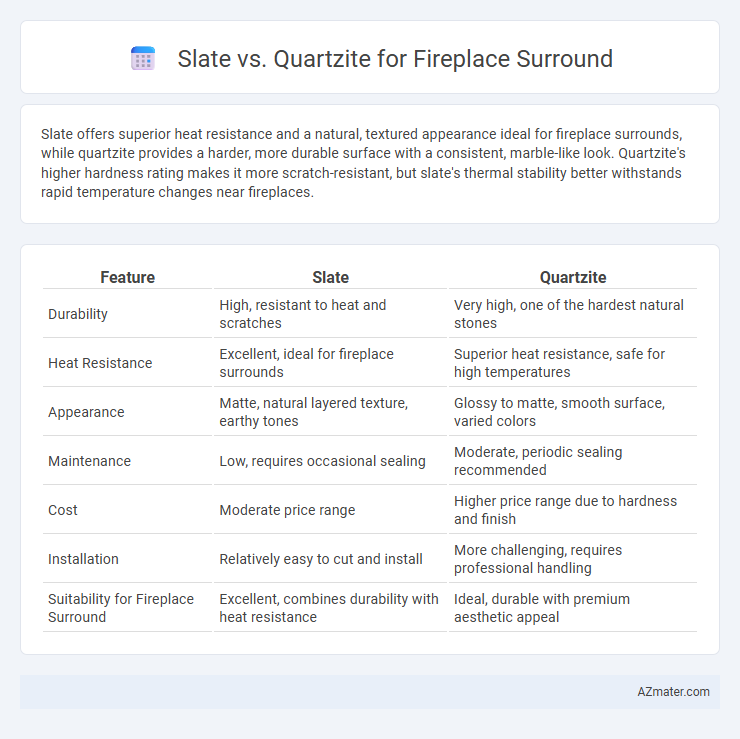Slate offers superior heat resistance and a natural, textured appearance ideal for fireplace surrounds, while quartzite provides a harder, more durable surface with a consistent, marble-like look. Quartzite's higher hardness rating makes it more scratch-resistant, but slate's thermal stability better withstands rapid temperature changes near fireplaces.
Table of Comparison
| Feature | Slate | Quartzite |
|---|---|---|
| Durability | High, resistant to heat and scratches | Very high, one of the hardest natural stones |
| Heat Resistance | Excellent, ideal for fireplace surrounds | Superior heat resistance, safe for high temperatures |
| Appearance | Matte, natural layered texture, earthy tones | Glossy to matte, smooth surface, varied colors |
| Maintenance | Low, requires occasional sealing | Moderate, periodic sealing recommended |
| Cost | Moderate price range | Higher price range due to hardness and finish |
| Installation | Relatively easy to cut and install | More challenging, requires professional handling |
| Suitability for Fireplace Surround | Excellent, combines durability with heat resistance | Ideal, durable with premium aesthetic appeal |
Introduction to Fireplace Surround Materials
Slate offers a natural, slip-resistant surface with a rich, dark appearance that enhances fireplace surrounds while being highly durable and heat-resistant. Quartzite, formed by metamorphosed sandstone, boasts a harder, denser composition that resists heat, scratches, and stains, making it ideal for high-traffic fireplace areas. Both materials provide unique textures and color variations, catering to aesthetic preferences and functional requirements in fireplace design.
What is Slate? Key Characteristics
Slate, a fine-grained metamorphic rock, is renowned for its durability and natural cleft texture, making it an excellent choice for fireplace surrounds. Its key characteristics include resistance to heat, low porosity, and a wide range of earthy colors such as gray, green, and purple. These properties provide both aesthetic appeal and practical functionality in high-temperature environments.
What is Quartzite? Essential Features
Quartzite is a natural metamorphic rock formed from sandstone subjected to intense heat and pressure, making it extremely durable and resistant to heat--ideal for fireplace surrounds. It features a glassy luster and a range of colors, often with subtle veining that adds a sophisticated, natural aesthetic. Its hardness and low porosity ensure excellent resistance to scratches, heat, and stains, distinguishing it from softer stones like slate.
Aesthetic Differences: Slate vs Quartzite
Slate offers a rich, textured surface with deep, earthy tones and natural cleft edges that create a rustic, organic fireplace surround. Quartzite presents a more polished, crystalline appearance with subtle veining and a glossy finish, lending a sophisticated and contemporary vibe. The aesthetic difference lies in slate's matte, rugged look versus quartzite's smooth, reflective elegance.
Durability and Heat Resistance Comparison
Quartzite offers superior durability and heat resistance for fireplace surrounds, with a Mohs hardness of 7, making it more resistant to scratching and chipping compared to slate, which ranges between 3.5 and 4. Slate is a natural metamorphic rock known for its heat resistance, but it can be more prone to flaking and requires sealing to prevent moisture damage. Quartzite's dense crystalline structure allows it to withstand higher temperatures and thermal shock better than slate, ensuring long-lasting performance in high-heat environments.
Maintenance Requirements for Slate and Quartzite
Slate fireplace surrounds require minimal maintenance due to their dense, non-porous surface, which resists stains and moisture. Quartzite, while also durable, demands more regular sealing to prevent etching and discoloration from acidic substances and heat exposure. Both materials benefit from gentle cleaning with pH-neutral products to preserve their natural beauty and longevity.
Cost and Installation Considerations
Slate typically costs between $5 to $15 per square foot, making it a budget-friendly option for fireplace surrounds, while quartzite ranges from $15 to $30 per square foot due to its rarity and durability. Slate is softer and easier to cut, allowing for less labor-intensive installation, whereas quartzite's hardness often requires professional tools and expertise, increasing installation costs. Both materials offer fire resistance, but choosing quartzite may lead to higher upfront costs balanced by long-term durability.
Design Versatility and Style Options
Slate offers a wide range of rich, earthy tones and textures ideal for rustic or traditional fireplace surrounds, while quartzite provides a sleek, marble-like appearance with subtle veining that suits modern and contemporary designs. Quartzite's natural hardness ensures durability and resistance to heat, making it a practical yet stylish choice that can mimic the look of high-end stone surfaces. Slate's layered structure allows for unique, dimensional designs that can be customized with various finishes, offering extensive style options for personalized fireplace aesthetics.
Pros and Cons of Slate for Fireplace Surrounds
Slate is highly durable and heat resistant, making it an excellent choice for fireplace surrounds due to its natural ability to withstand high temperatures without cracking. Its rich, textured appearance adds a rustic and elegant aesthetic that complements various interior styles. However, slate can be prone to chipping and may require sealing to prevent moisture absorption and staining, which could impact long-term maintenance.
Pros and Cons of Quartzite for Fireplace Surrounds
Quartzite offers exceptional heat resistance and durability, making it a top choice for fireplace surrounds that endure high temperatures. Its natural, elegant appearance with a variety of colors and patterns enhances aesthetic appeal, while being less prone to scratching and etching compared to softer stones. However, quartzite requires professional installation due to its hardness and may incur higher costs, plus its porous nature demands periodic sealing to prevent staining.

Infographic: Slate vs Quartzite for Fireplace Surround
 azmater.com
azmater.com